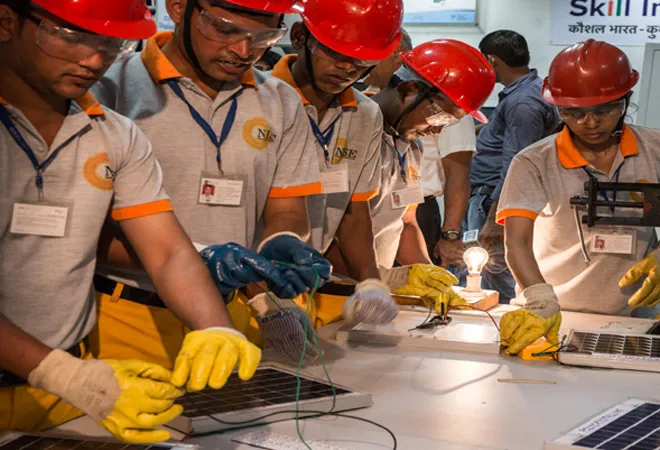
Since 2014, World Youth Skills Day is celebrated across the globe to recognise the need to invest in the skills of our youth for future employment and to build a spirit of entrepreneurship. Youth between the ages of 15-24 make up
1.2 billion people, accounting for
16 percent of the global population and is projected to increase to
1.3 billion by 2030. A few developing countries have also been experiencing the “
youth bulge”, resulting in a large share of children and young adults. Remarkably while this phenomenon will have immense potential to fuel the next generation of workers and leaders, there is an underlying risk of it turning into a demographic bomb if enough opportunities are not created. One such effort is the aim of
Sustainable Development Goals 4 which focuses on generating life cycle learning opportunities and bolstering pathways to impart skills through investing in quality technical and vocational education. According to
UNESCO,
Technical and Vocational Education and Training (TVET) refers to the acquisition of a wide range of educational, training, and skill development processes for catering to cross-cutting occupational fields, production services and livelihoods. It also emphasises the facilitation of decent work and lifelong learning, empowering individuals and communities for inclusive and sustainable economies.
One such effort is the aim of Sustainable Development Goals 4 which focuses on generating life cycle learning opportunities and bolstering pathways to impart skills through investing in quality technical and vocational education.
India’s youth skills enabling journey
India has this unique window of opportunity to unlock the potential of its youth with
1.1 billion people estimated to be in the working age group
(15-64) by 2047. TVET has the potential to provide equitable jobs for 1 million young people who enter India’s job market per month. Acknowledging the need for establishing a network of formal institutions to provide an array of skill sets including reskilling and upgrading, India has already embarked on a systemic shift to ready its working age population for jobs of the future. The
Ministry of Skill Development and Entrepreneurship (MSDE) operates its umbrella scheme, the
Skill India Mission launched in 2015 with an overarching objective to develop a skilful youth workforce of the future. by providing proper skillset training to
over 400 million young people by the year 2022
The
Pradhan Mantri Kaushal Vikas Yojana (PMKVY) is a skill certification scheme of the MSDE implemented by the
National Skill Development Corporation (NSDC) which aims to mobilise and equip the youth population with the necessary skill sets training. The scheme also incorporates specialised components such as the
National Skills Qualifications Framework (NSQF)—a nationally integrated education framework designed to enable candidates to acquire desired competency levels;
Recognition of Prior Learning Learning (RPL)—skill certification for youth, especially in the unregulated sectors;
Kaushal—a hands-on awareness-based approach with the intention of attracting potential candidates for skill training; and the
Rozgar Mela—a career placement fair for young jobs seekers.
Then came the
PMKVY 2.0 in 2016-20 with an aim to target 10 million young people by e equipping them with demand-driven skill sets through
short-term trainings,
Recognition of Prior Learning (RPL), and
special projects programme.
India has this unique window of opportunity to unlock the potential of its youth with 1.1 billion people estimated to be in the working age group (15-64) by 2047.
Under the
PMKVY 3.0 , launched in 2020-21, more than 7.36 lakhs candidates were trained with another 1.2 lakh benefiting from the
Customised Crash Course for COVID warriors. In consultation with the Ministry of Education (MoE), this programme has also envisaged the
Skill Hub Initiative to create an industry skilled work force. It broadly focuses on creating a skilled workforce that matches the current trends in the job market, incorporating and mainstreaming vocational training within the
National Education Policy 2020, and linking the hub with local skilling institutions and universities with a robust funding mechanism.
It has also been announced that the PMKVY 4.0 will be launched soon to take skill development to a wider young segment in the coming three years. Finance Minister Nirmala Sitharaman in
her 2023 Budget speech in the Parliament declared that the scheme will lay special emphasis on hands-on training, industry partnerships along with convergence of needs-based courses for youth skilling. The scheme will also cover niche new age technologies such as coding, Artificial Intelligence (AI ), robotics
, mechanotrics, Internet of Things (IOT ), 3D-printing, drones, and developing other soft skills. With
13.2 million candidates trained since 2015, a futuristic PMKVY 4.0 promises focus greater gender diversity including women from tribal regions, developing a female workforce on Electric Vehicle (EV ) manufacturing and solar engineering, reskilling and upskilling for those who lost jobs in the COVID pandemic.
The National Policy on Skill Development and Entrepreneurship 2015, provides for an overarching blueprint for all skilling activities carried out within India, connecting them to a uniform standard of skilling requirements, interlinked with demand centres.
The
National Apprenticeship Promotion Scheme (NAPS), launched in 2016 has been promoting Apprenticeship in the country through financial incentives, technology, and advocacy support.
The Skill Loan Scheme was launched in July 2015 to provide finance to the youth for enrolment in skill development courses that match quality control thresholds such as to National Occupations Standards and Qualification Packs to obtain certified degrees by training institutes as per National Skill Qualification Framework (NSQF) guidelines.
The
Pradhan Mantri Yuva Udyamita Vikas Abhiyan (PM-YUVA) was launched in 2016 as an all-India scheme to promote business studies, and facilitate access to entrepreneurship support networks and start-ups ideas for the youth. Programmes such as
Project AMBER (Accelerated Mission for Better Employment and Retention) is a joint collaboration of the
National Skill Development Corporation (NSDC) and
Generation India Foundation (GIF) with MSDE as the nodal agency that strives to provide holistic skilling to foster quality jobs, improved employment opportunities and retention methods. The
Skill Loan Scheme was launched in July 2015 to provide finance to the youth for enrolment in skill development courses that match quality control thresholds such as to
National Occupations Standards and
Qualification Packs to obtain certified degrees by training institutes as per
National Skill Qualification Framework (NSQF) guidelines. Another significant intervention is the
Skill Impact Bond pioneered by the NSDC focuses on a result/outcome-driven plan of action that prioritises job placements and retention strategies. The Public Private Partnership (PPP) focuses on leveraging real employment to trainees rather than certification has been successful in enrolling nearly
18,000 first time job seekers from low-income families of which
72 percent were women.
In spite of these policy interventions, India is staring at a
29-million skill deficit by 2030, according to the International Labour Organisation (ILO) with an estimated
US$ 1.97 trillion skill deficit in terms of Gross Domestic Product (GDP) over the next decade.
The National Policy for Skill Development and Entrepreneurship (NPSDE) 2015 estimates that only 5.4 percent of the workforce in India has undergone formal skill training as compared to 68 percent in the United Kingdom, 75 percent in Germany, and 96 percent in South Korea.
The Public Private Partnership (PPP) focuses on leveraging real employment to trainees rather than certification has been successful in enrolling nearly 18,000 first time job seekers from low-income families of which 72 percent were women.
It is about time to plug in the gaps in schematic approaches to bridge the demand-supply chasms. According to an
analysis, only one in four or 22.2 percent of those certified under the PMKVY had found jobs as of 14 March 2023. It also states 1,986,000 people received training with a placement percentage of 18.4 percent in phase 1, PMKVY 2.0 was longest among the three phases with the highest number of candidates trained standing at 10,998,000 with the highest percentage of placements at 23.4 percent, then came the PMVY 3.0 which saw 445,000 trainees with a placement percentage of 10.1 percent.
Skill-proofing for the road ahead
Clearly more needs to be done to ensure that countries do not miss out on their demographic window and to ensure that they invest in their vast human capital. To begin with efforts to improve the quality of basic education should go hand-in-hand with adequate testing along with measurable indicators comparable across countries. This perhaps can then pay off well as young people are exposed to vocational skills as an aspirational career choice in early school curriculum and are already prepared and aware of the expectations from technical training.
Studies have indicated the importance of interlinking early education to technical training culminating into competencies required to enter the industry along with other life skills. A systematic mapping of skill requirements can also enable designing a demand-driven skill enhancement ecosystem and aid in exploring current trends in workforce demand and supply. Engaging with industry stakeholders to generating and sharing of data for skill requirements on a timely basis can be utilised by nodal ministries for annual assessment and monitoring. Conducting labour market assessment studies with a focus on future jobs can be utilised to observe changes in industry demands such as the emerging care, digital, and green economy to develop the requisite skill sets to incorporate them in current training curriculum.
A systematic mapping of skill requirements can also enable designing a demand-driven skill enhancement ecosystem and aid in exploring current trends in workforce demand and supply.
The Parliamentary Standing Committee on Labour, Textiles and Skill Development in its
36th report observed that the programme has greatly suffered due to the underutilisation of funds and high dropout rates. Identifying various long-term ways and result-based funding will perhaps go a long way to close the funding gap. A continuous upgrading of the underlying skill training infrastructure with a gender balanced number of certified trainers can encourage more women candidates to join the training sessions. With female labour participation rate at
22 percent, way below as compared to an average of around 70 of that of the United States, China, and the UK, experts have argued that India must ensure that enough measures are undertaken to challenge historical gender inequality and create at least
43 million jobs for women in the next 10 years. Skilling India’s
13 million youngsters who enter the job market each year is a daunting task but by fixing some of the leakages in the pipeline, we can perhaps maximise our demographic dividend for the workforce of the future.
Arundhatie Biswas is a Senior Fellow at the Observer Research Foundation.
The views expressed above belong to the author(s). ORF research and analyses now available on Telegram! Click here to access our curated content — blogs, longforms and interviews.



 Since 2014, World Youth Skills Day is celebrated across the globe to recognise the need to invest in the skills of our youth for future employment and to build a spirit of entrepreneurship. Youth between the ages of 15-24 make up
Since 2014, World Youth Skills Day is celebrated across the globe to recognise the need to invest in the skills of our youth for future employment and to build a spirit of entrepreneurship. Youth between the ages of 15-24 make up  PREV
PREV


